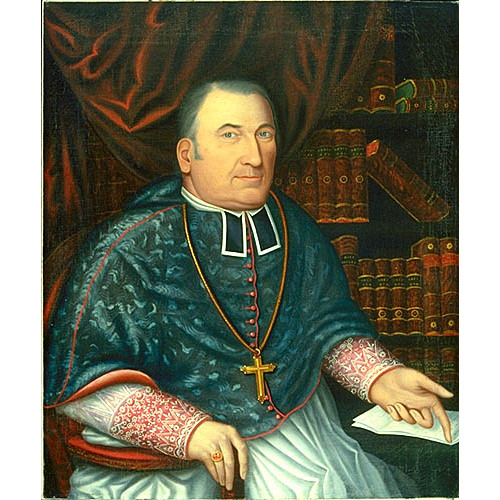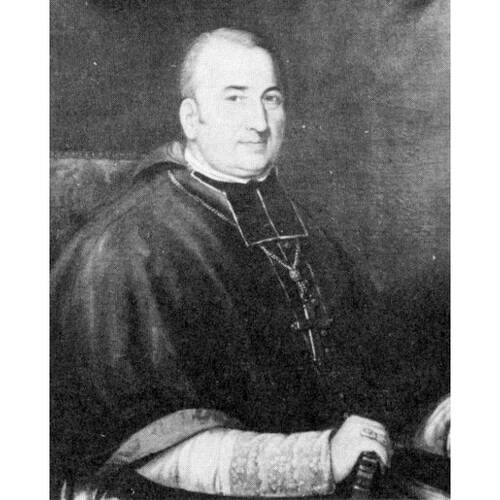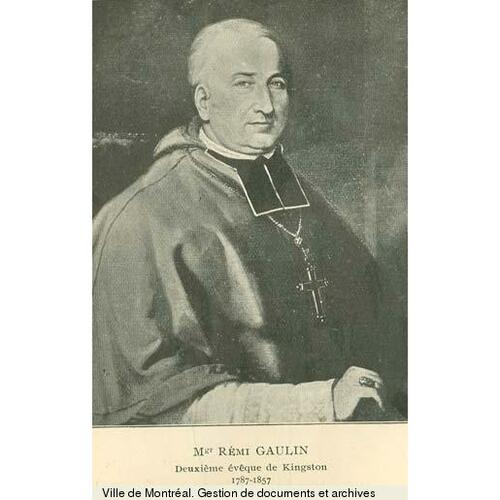
Source: Link
GAULIN, RÉMI (as bishop he signed Remigius), Roman Catholic priest and bishop; b. 30 June 1787 at Quebec, son of François Gaulin, a cooper, and Françoise Amiot; d. 8 May 1857 in Sainte-Philomène (Mercier), Lower Canada.
After classical and theological studies at the Séminaire de Québec and, from 1807 to 1810, further theological studies at the Séminaire de Nicolet, Rémi Gaulin served as secretary to Bishop Joseph-Octave Plessis* on a pastoral visit to the Îles de la Madeleine and New Brunswick in June and July 1811. On 13 October he was ordained in Quebec by Plessis, who immediately named him curate to the Reverend Alexander McDonell* in Glengarry County, Upper Canada. The young priest was very contented there. Described by his superiors as a sensible and likeable man, he ministered to the Catholics in Kingston during the early months of 1812 and made preparations for a church to be built. From June 1812 until the spring of 1815 he was in charge of the parishes at St Raphael (St Raphael West) and St Andrews. He saw service during the War of 1812 as a military chaplain. Having worked with McDonell for nearly four years, Gaulin, despite the desire expressed by Catholics in Kingston to have him placed in their parish, went back to Quebec in May 1815 in order to accompany Bishop Plessis on a pastoral visit to the missions on the Gulf of St Lawrence.
The bishop’s arrival at Arichat, Cape Breton Island, on 3 July 1815, attracted a number of the region’s clergy, including François Lejamtel*, Antoine Manseau*, Alexander Macdonell*, and Angus Bernard MacEachern*. The next day Plessis assigned Gaulin to be the first resident pastor of St Ninian’s parish in Antigonish, N.S., with responsibility for Margaree and Chéticamp, Cape Breton. He set out immediately, taking, he later wrote, nothing but “my soutane and my breviary.” In serving Antigonish, Gaulin was following in the footsteps of his great-granduncle Antoine*, who had ministered to the same locale nearly 100 years earlier. In anticipation of the establishment of a vicariate apostolic in Nova Scotia [see Edmund Burke*], Gaulin transferred to Chéticamp and by October 1816 was serving the Acadians of that community and of Margaree, and the Scots living in the Bras d’Or Lake district. In July 1819 he took charge of the Arichat mission, reporting to Plessis at the end of 1821 that the Catholic population there totalled 2,704.
Gaulin seems to have been unhappy in the Maritimes. He experienced continuing financial problems that included indebtedness to a fellow priest; he encountered “the most consummate ignorance” of religion throughout the Scots settlements he served and was frustrated by his inability to instruct these Catholics in their Gaelic language. Compounding his problems was a lengthy illness that began in February 1816 and lasted several months. It may be for these reasons that Gaulin asked to be allowed to return to Quebec. In October 1817 Plessis granted permission for him to depart the following summer, stating that he would probably be posted to Upper Canada where Alexander McDonell ardently sought his return. Although Plessis repeated his permission in April 1818, nothing came of the request until September 1822 when, following the arrival of his successor, Hyacinthe Hudon*, Gaulin returned to Quebec, probably taking with him the ailing William Dollard.
Perhaps to compensate Gaulin for lengthy service in remote missions, or simply to make use of his command of English, his superiors then placed him in a number of parishes around Montreal. In November 1822 he was assigned to serve Saint-Luc on the Rivière Richelieu and, a month later, to minister as well to Saint-Athanase (in Iberville). Gaulin was transferred to L’Assomption in January 1825, where he had responsibility for four outlying missions. He returned to the Rivière Richelieu in October 1828 to replace Augustin-Magloire Blanchet* at Dorchester (Saint-Jean-sur-Richelieu) and, some two years later, was also given the new parish at nearby Saint-Valentin. In October 1831 he was assigned to Sainte-Scholastique (Mirabel), and then moved a year later to Sault-au-Récollet (Montreal North). Gaulin performed a variety of duties during these years, including teaching theology to Étienne Chartier. He impressed his superiors and was popular with his parishioners. Bishop Bernard-Claude Panet* stated that Gaulin preached with grace and dignity and, later, that he had refused the request of parishioners from Saint-Jean seeking Gaulin’s return. Clearly, here was someone with promise.
Meanwhile, Alexander McDonell, Gaulin’s first superior, had been appointed bishop of Kingston in 1826. His long and frustrating search for a coadjutor to help him administer a diocese comprising the whole of Upper Canada had involved the resignation of Thomas Weld in 1830 and the refusal of Thomas Maguire, John Larkin, and Joseph-Vincent Quiblier to accept the post. Renewing his efforts, McDonell in 1832 again requested a coadjutor, citing his infirmities and advanced age, and he invited his episcopal colleagues to find him a worthy candidate. In order to reduce friction within his diocese, McDonell sought a French Canadian rather than a Scots or Irish candidate. Bishop Jean-Jacques Lartigue* recommended Antoine Manseau and Gaulin, preferring the latter because of his proficiency in English and, ironically as it was soon to prove, because of his superior health. McDonell welcomed Gaulin’s candidacy with enthusiasm since Gaulin was well acquainted with Upper Canada as a result of having worked there for nearly four years. He had also acquired some facility in Gaelic while in the Maritimes. Accordingly, on 20 Oct. 1833 Gaulin was consecrated bishop of Thabraca in Numidia and made coadjutor to McDonell with right of succession. The ceremony, which took place in Montreal, was performed by Lartigue, with the assistance of Louis-Marie Cadieux* and Jacques-Guillaume Roque*.
Over the next several years Gaulin occupied himself with the many problems peculiar to a young, pioneer diocese of vast size. On one of his extensive pastoral trips he visited Penetanguishene and, convinced that a pious and zealous missionary might accomplish much good there, he assigned Jean-Baptiste Proulx* in 1835 to work in that region. At the end of 1835 McDonell ceded to Gaulin the entire administration of the diocese, which was then estimated to consist of 32 missions, 22 pastors, and some 60,000 Catholics. Among the vexing difficulties Gaulin faced were the lack of clergy, laxity among both priests and laity in observing the faith, and clerical insubordination, especially that of William John O’Grady*.
Gaulin succeeded to the bishopric in 1840 when McDonell died. The next year, however, marked the beginning of a decline in physical and mental health that dogged him until his death, although his illness did not entirely prevent him from functioning, at least initially. Among his early achievements in office were the establishment in Kingston in 1841 of the sisters of the Congregation of Notre-Dame [see Marie-Françoise Huot*, named Sister Sainte-Gertrude]; the creation of the diocese of Toronto the same year and the consecration of its first bishop, Michael Power*, on 8 May 1842; preparations in the summer of 1842 for the commencement of work on Kingston’s cathedral; and the beginning of classes at Regiopolis College the same year. Gaulin also continued to make extensive pastoral visits throughout his diocese.
Nevertheless, despite Gaulin’s initial successes, deteriorating health soon made his position untenable. Bishop Ignace Bourget* tried to help by letting Gaulin rest in Montreal during the summer of 1841. It was apparently not enough, for that September Kingston’s vicar general, William Peter MacDonald*, wrote directly to the authorities in Rome demanding a replacement for the physically and mentally ailing bishop. The following August Father Jean-Charles Prince stated that Gaulin “is no longer able to look after any matters,” a sentiment echoed by Bishop Power two months later. Another priest gave a detailed description of Gaulin’s behaviour in letters written in the summer of 1843: “A constant watch must be kept because he goes out of his bedroom with no clothes on, calls for people never heard of, refuses to eat, closes his doors .... Imagine how painful and shameful it is to have someone of his rank [about] in the centre of the town.” In another letter he added: “He can only be approached at his own pleasure; he spends whole days taking no food; he leaves his room all of a sudden and shows up at the kitchen without being decently dressed. . . . And then [imagine] when he became infuriated . . .” His condition at times even required a strait-jacket. There was no doubt that decisive action was necessary. Despite Gaulin’s wish for a further division of his diocese rather than an assistant, the Canadian episcopate moved vigorously to secure a coadjutor and in the spring of 1843 Bourget informed Gaulin that Patrick Phelan had been chosen for that office.
While waiting for the pontifical bulls to arrive, Bishop Power decided to take charge of the diocese of Kingston. In June 1843, taking advantage of a temporary tranquillity in Gaulin’s condition, he secured the sick man’s signature to a letter transferring all his powers to the bishop of Toronto. Power noted that Gaulin was unsympathetic to Phelan, and he expressed the view that Gaulin was “completely insane, believing himself in the Orient and wanting his poor housekeeper to explain to him the manner and route by which she had conveyed herself from Kingston to the Holy Land to bring him soups.” Within weeks Bourget was in Kingston where he successfully persuaded Gaulin to return with him to Montreal. Phelan received his bulls in July and was consecrated in August. Gaulin, although by then in Lower Canada, remained the bishop of Kingston and only gradually relinquished control of his diocese to Phelan. Bourget aided the transition by appointing Gaulin vicar general of the diocese of Montreal, president of the corporation of the Collège de L’Assomption (October 1844), and then, for the second time in his career, curé of L’Assomption (September 1845).
For several years Gaulin was well enough to be of considerable assistance to Bourget in furthering the work of the Montreal diocese. He took an active interest in the college, built a convent in L’Assomption, and ordained or conferred minor orders on a number of people, including François-Maximilien Bibaud*, Joseph-Julien Perrault*, John Farrell*, and Albert Lacombe*. He also participated in the consecrations of bishops Augustin-Magloire Blanchet and Joseph-Bruno Guigues*. But Gaulin never really lost interest in his own diocese and between 1849 and 1852 attempted to regain control of it; the result was turmoil that repeatedly involved the church’s hierarchy in both the Canadas and Rome.
Gaulin returned to Kingston late in 1849 and, to the confusion of the diocese’s clergy, the following February appointed Patrick Dollard* and others to his own administrative council prior to beginning work on a number of projects. The bishops in the Canadas reacted swiftly, reminding Gaulin that Phelan possessed full episcopal authority and that Rome had left him the title bishop of Kingston only to let him retire with honour. They advised him to give up administrative responsibility for his diocese. Although in April he agreed to do as his fellow bishops counselled, by June he had reversed his decision. Gaulin, despite the fact that Rome had renewed Phelan’s office without reference to him, convened and chaired a meeting of the episcopal council that he had appointed. The council passed resolutions affirming that Gaulin was fit once more to administer his diocese, and this responsibility he indeed resumed. In December 1850 the bishops of the ecclesiastical province of Quebec issued another declaration on the Gaulin affair, but he remained intransigent: “As long as I am not to be canonically removed from my see, I will act as bishop of Kingston.” In April 1851 Gaulin received a letter from Cardinal Giacomo Filippo Fransoni, prefect of the Sacred Congregation of Propaganda in Rome, emphasizing that Phelan alone governed the diocese of Kingston. Visibly affected, but convinced that most of the clergy preferred him to Phelan, Gaulin declared that he would continue to intervene in diocesan matters when necessary. One priest expressed the view that the clergy would opt for Phelan not from affection, but to avoid a greater evil.
The troubles were by no means over. During the first provincial council of Quebec, the assembled bishops persuaded Gaulin to bow to the pope’s will, which he did in a letter dated 26 Aug. 1851. Two days later Bishop Pierre-Flavien Turgeon* sent a circular letter to the clergy in the diocese of Kingston reminding them that Phelan had sole responsibility for the administration of the diocese. The solution turned out to be short-lived. Gaulin recanted and in December 1851 Pope Pius IX himself had to warn him not to meddle with the governance of his diocese in the future. His health broken, Gaulin retired to Sainte-Philomène, Lower Canada. Although calm was gradually restored in the ensuing months, he continued to be an encumbrance to Phelan until the day he died, on 8 May 1857. His remains were transferred to Kingston and buried on 13 May in St Mary’s Cathedral, where a likeness of his mitred head was later carved.
Rémi Gaulin’s report of 25 Sept. 1838 describing a missionary journey in western Upper Canada was printed in the Annales de la Propagation de la Foi (Lyon, France, et Paris), 12 (1840): 425–32, under the title “Lettre de Mgr. Gaulein, coadjuteur de Kingston, à son évêque,” and in the Assoc. de la Propagation de la Foi, Rapport (Montréal), no.3 (1841): 53–58, as “Mission chez les sauvages du Haut-Canada.” The version published in the Annales is followed on page 432 by “Extrait d’une lettre du même au Conseil central de Paris,” an excerpt from Gaulin’s letter of 14 April 1840 requesting two missionaries to serve at Lake Superior. Gaulin’s other letters to the society are held in the Arch. de la Propagation de la Foi (Paris), F 178, microfilm copies of which are available at the Centre de Recherche en Hist. Religieuse du Canada, Saint Paul Univ., Ottawa.
In addition to the archives cited below; source material relating to Gaulin’s episcopacy is held at the AAT. Those holdings and their inventory, “Documents and letters relating to the history of the Catholic Church in the western part of the Diocese of Upper Canada prior to the establishment of the Diocese of Toronto, December 17th, 1841,” comp. G. A. Bean (Toronto, 1970), are also available on microfilm at the AO.
Likenesses of Gaulin include the carving referred to in the text, and a painting in the bishop’s residence at Kingston reproduced in L. J. Flynn, Built on a rock; the story of the Roman Catholic Church in Kingston, 1826–1976 (Kingston, Ont., 1976).
AAQ, 301 CN, I: 36–61. ACAM, 255.102, 832-3, -4; 833-7–8; 834-2, -7; 835-1, 837-7; 838-1; 839-5; 840-4; 842-8–11; 843-6–7; 849-1; 850-11–12; 851-2, -8, -19; 255.104, 842-3–4; 843-7, -9; 295.101, 850-48. ANQ-Q, CE1-1, 30 juin 1787. Arch. of the Archdiocese of Kingston, AI (Alexander MacDonell papers, corr.), 1C13-5, -7; 1C15-1; 2C1-19–20, -23; 2C7-16; 3C3-9–13; 5ED1-1; 5ER1-16; B (Remigius Gaulin papers), especially I (corr.), 1C8-1; CI (Patrick Phelan papers, corr.), 1C10-3; 2C3-2; 2C6-14; 3C14-12, -14; 4CL1-1; 4ED1-4; 4ER1-5; 4ER2-1, -9, -11. ASQ, Fonds Viger–Verreau, Sér.O, 0139–52. PAC, RG 5, A1: 73255–57. Daily British Whig, 12–15 May 1857. Toronto Mirror, 13 Oct. 1848; 15, 22 May, 12 June 1857. Allaire, Dictionnaire, 6: 297. F.-M. Bibaud, Le panthéon canadien (A. et V. Bibaud; 1891). Caron, “Inv. de la corr. de Mgr Panet,” ANQ Rapport, 1933–34, 1934–35, 1935–36; “Inv. de la corr. de Mgr Plessis,” ANQ Rapport, 1927–28, 1928–29, 1932–33; “Inv. de la corr. de Mgr Signay,” ANQ Rapport, 1936–37, 1937–38. L.-A. Desrosiers, “Correspondance de Mgr Ignace Bourget . . . ANQ Rapport, 1945–46, 1946–47, 1948–49; “Inv. de la corr. de Mgr Lartigue,” ANQ Rapport, 1941–42, 1942–43, 1943–44, 1944–45, 1945–46. Le Jeune, Dictionnaire. Léon Pouliot et François Beaudin, “Correspondance de Mgr Ignace Bourget,” ANQ Rapport, 1955–57, 1961–64, 1965, 1966, 1967, 1969. Tanguay, Dictionnaire, 4: 201. Douville, Hist. du collège-séminaire de Nicolet, 2: 3–5. A. A. Johnston, Hist. of Catholic Church in eastern N.S. Lemieux, L’établissement de la première prov. eccl. C. Roy, Hist. de L’Assomption, 221–22.
Cite This Article
J. E. Robert Choquette, “GAULIN, RÉMI (Remigius),” in Dictionary of Canadian Biography, vol. 8, University of Toronto/Université Laval, 2003–, accessed April 15, 2025, https://www.biographi.ca/en/bio/gaulin_remi_8E.html.
The citation above shows the format for footnotes and endnotes according to the Chicago manual of style (16th edition). Information to be used in other citation formats:
| Permalink: | https://www.biographi.ca/en/bio/gaulin_remi_8E.html |
| Author of Article: | J. E. Robert Choquette |
| Title of Article: | GAULIN, RÉMI (Remigius) |
| Publication Name: | Dictionary of Canadian Biography, vol. 8 |
| Publisher: | University of Toronto/Université Laval |
| Year of revision: | 1985 |
| Access Date: | April 15, 2025 |





